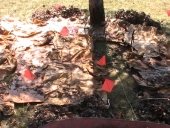"...this layer will often create a layer that cannot be penetrated by air or water"
That's not been my experience, although I guess it could be in other climates. The first creatures visible under the cardboard are worms and sowbugs. The worms and coming and going, as I can see their holes when I lift the cardboard. Almost immediately, the layer of cardboard on the bottom starts to rot and show signs that something is eating on it. It breaks down fastest under rocks or bricks, and next is under a good mulch. The last to break down are the cardboard surfaces exposed to sunlight and air -- I think the drying effect is what is 'preserving' it.
A couple of years ago, a neighbor set some old plywood out to take to the dump. I was looking for a simple way to keep the weeds and grass down in a hard-to-mow area, and wondered if just laying the plywood down would do the job, so I did some research.
I discovered that indoor plywood has a urea/formaldehyde adhesive, and outdoor plywood has a phenol/formaldehyde adhesive. Urea is a form of nitrogen fertilizer by itself, and neither the phenol nor the formaldehyde lasts long when composted, about two weeks, IIRC. Higher additions of nitrogen assisted with the breakdown of the plywood and the adhesives. With the breakdown of the phenol and formaldehyde in compost, the researchers said plywood would be okay to use in those large commercial composting sites (where they use large equipment to turn the windrows of compost).
While it may not be to organic standards, I was only using it in a few places that were highly unlikely to be used for food production, anyway.
I hadn't really thought about cardboard having formaldehyde, so I just looked it up, and at a British/organic site, they had this to say about corrugated cardboard:
"The type of cardboard you describe does not usually contain glue as it is made from cellulose fibres which stick together naturally. It is a great addition to your compost heap or can be used for mulching."
http://perrone.blogs.com/horticultural/2008/02/i-recently-had.html However, this article only specified
corrugated cardboard, not any other kind.
And, since I have had the best results with cardboard (my sources of covering mulch is often limited), I will continue to use it.
Sue




























































